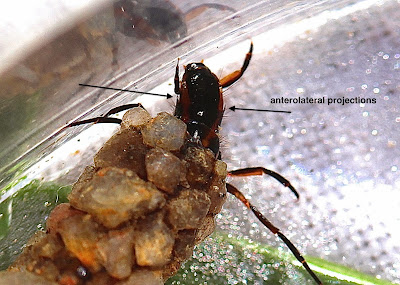I went to the upper Doyles River this morning where I found -- among other things (photos later) -- this Strong-case maker, Psilotreta labida. If you look back at the entry posted on 10/29 you'll see that I found a Strong-case maker that day that I thought might be the species Psilotreta frontalis -- though at that time I was not totally sure. I'm now fairly certain of that ID, so I thought I'd take this opportunity to revisit the issue.
1. Psilotreta labida -- Doyles River, 11/19
The head was so black on this larva that at first I wasn't sure it was P. labida, but as it turns out, that's a key to species ID. Let's review.
P. labida -- larvae up to 13 mm; coloration variable, usually frontoclypeus entirely black with broad stripe extending to occipital foramen and usually darker than P. frontalis; pronotum with dark stripe broad sometimes nearly obscuring ground color; anterolateral pronotal projections long and acute; mesonotum nearly all dark. Spring fed and larger streams. (Steven Beaty, "The Trichoptera of North Carolina," p. 97)
Since the nature of the pronotal "anterolateral projections" is a key distinction between our two species, let's look at that first.
No question, they're long and acute. But is the "frontoclypeus" entirely black, the dark stripe on the pronotum broad, and the mesonotum "nearly all dark"?
Using this microscope view, I'd answer "yes" to all of those questions. Psilotreta labida.
________________
2. Psilotreta frontalis -- tiny stream at Montfair Farm, 10/29
Now to the larva -- actually there were several -- we found on 10/29. While the "coloration" of P. frontalis is, like that of P. labida, "variable," Beaty does note some slight differences in the colors of the pronotum and mesonotum. "dark on pro- and mesonotum confined to middle stripes and lateral edge; pronotum with anterior edge slightly darker than ground color."
In the photos below, the differences with P. labida in terms of the pro- and mesonotal colors are quite pronounced.
The mesonotum, in particular, is quite a bit lighter on P. frontalis. And then, there are the anterolateral projections on the pronotum: on P. labida they're "long and acute"; on P. frontalis they're "relatively short."
They sure are.
There's one other way to distinguish P. frontalis from P. labida: habitat. While P. labida can be found in "larger streams," P. frontalis seems to only be found in small head-water streams that are spring fed -- i.e. first order streams. This point is made by Beaty, but by other authors as well. Thomas Ames, for example, notes that, in contrast to P. labida, "P. frontalis favors smaller streams" (Caddisflies, p. 214), and Ernie Schweibert comments "Psilotreta frontalis seems most abundant in small streams." (Nymphs, Volume II, p. 135) The stream I explored on 10/29 was one of the smallest streams I've looked in for insects: it was clearly a first order stream. We do indeed have two Strong-case makers that live in our streams.
One final point. I sent my "P. frontalis" photos to Steven Beaty and asked his opinion. He agreed that they looked like frontalis. However, he added that the real test to see if a larva is labida or frontalis is to check the setal pattern on the head, "particularly the length of seta 15 and 17." Oh dear!
_______________
Most of the insects I found today at the Doyles could be expected at this time of the year. Just a few photos.
1. Small winter stonefly, Allocapnia pygmaea. Seeing small winters in significant numbers now.
2. Large winter stonefly, Taeniopteryx burksi/maura
3. Pronggilled mayfly, genus Paraleptophlebia. The most common taxon in the river today.
4. Perlodid stonefly, Helopicus subvarians.
5. And this odd-looking Perlodid that had just recently molted.
It too turned out to be Helopicus subvarians! Should have known it by the "mask" on the face.
















No comments:
Post a Comment